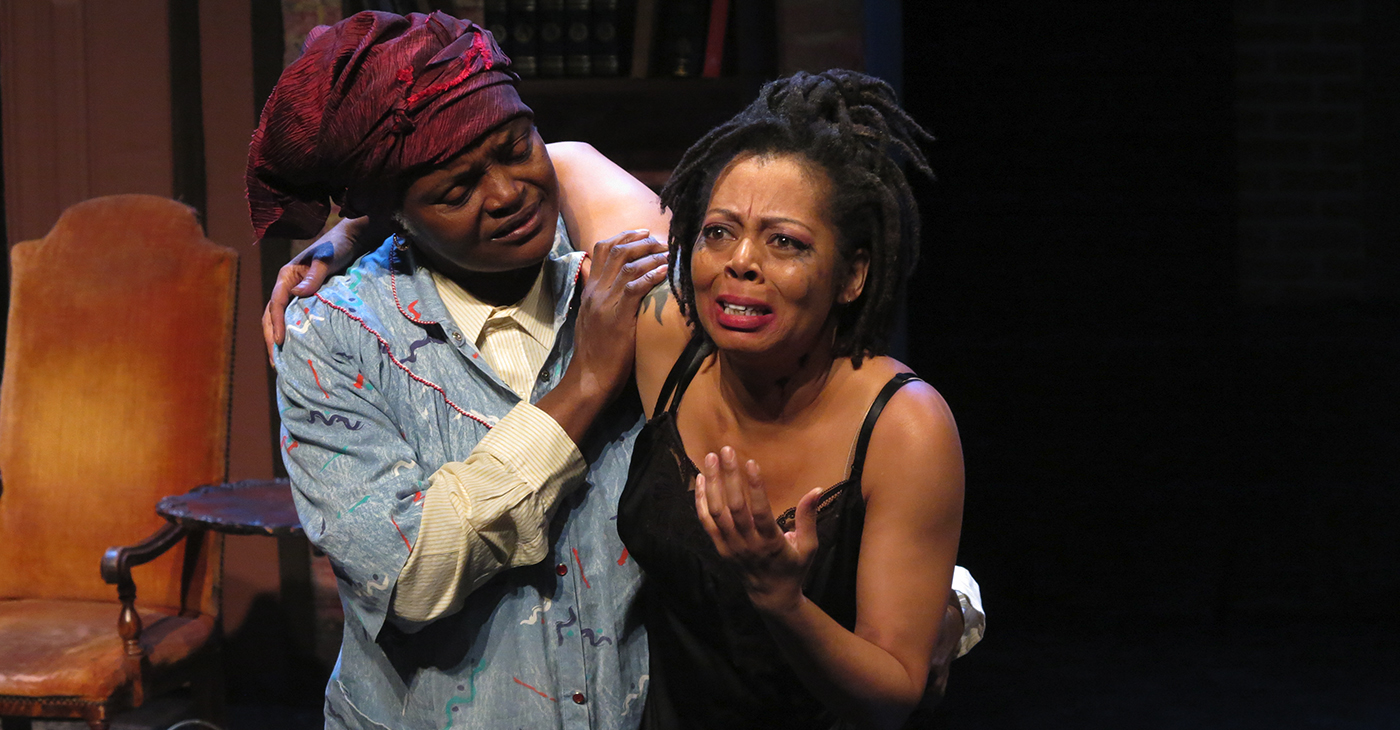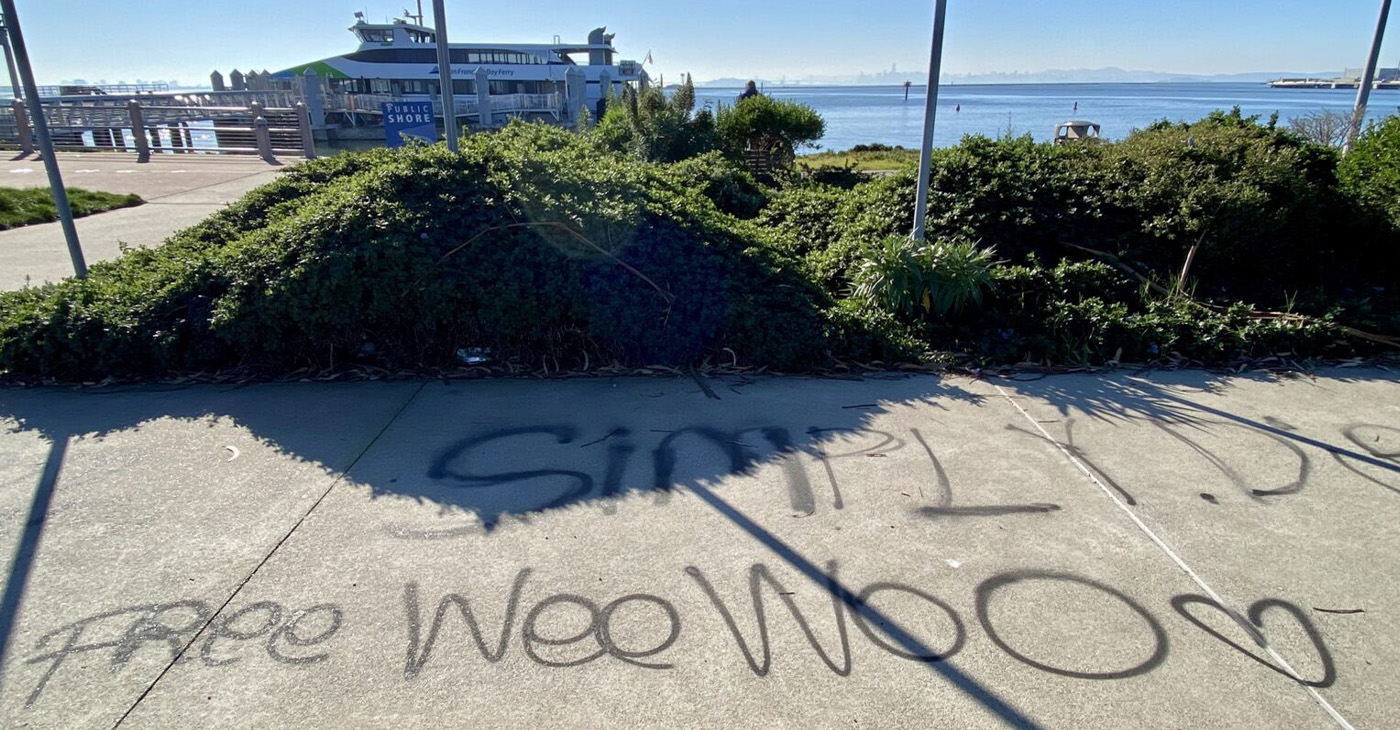Art
REVIEW: Ishmael Reed’s Play “The Slave Who Loved Caviar,” Comments on Black Artists and White Sponsors
[Haitian-Puerto Rican American artist, Jean-Michel] Basquiat rose to fame in the neo-expressionist art movement in the 1980s and [Andy] Warhol, one of his mentors, had gained renown for Pop Art and drug use in the 1960s. They died within a year of each other, Warhol at age 59 in 1987 and Basquiat died of an overdose at age 27 in 1988.

By Wanda Sabir
Ishmael Reed’s current play, directed by Carla Blank, “The Slave Who Loved Caviar,” at Theater for the New City until January 9, explores Black culture and white exploitation in the relationship between the Haitian-Puerto Rican American artist, Jean-Michel Basquiat and Andy Warhol.
Basquiat rose to fame in the neo-expressionist art movement in the 1980s and Warhol, one of his mentors, had gained renown for Pop Art and drug use in the 1960s. They died within a year of each other, Warhol at age 59 in 1987 and Basquiat died of an overdose at age 27 in 1988.
There are so many analogous parallels, both fictional or mythic and actual that it is amazing that the play only has one intermission.
In his play, Reed postulates that the older, white artist presented himself as a benevolent father figure. While under the influence of drugs, a willing Basquiat allows Warhol to install him in a basement where Basquiat churns out art like an assembly worker.
Reed’s premise here is that Warhol had gotten away with a crime.
The cold case is reopened by two forensic scientists, Grace and Raksha, (Monisha Shiva and understudy Kenya Wilson) who want to bring the perpetrators to justice. As the contemporary team investigates, time shifts back and forth as what happened to Basquiat had perpetuated with other captives.
Slave owners used cocaine — which Basquiat used excessively — to increase productivity among the captives, Reed says. Just as slavery was once legal, the Warhol machine also had legal protection, money and power.
Reed’s writing is crisp and sharp as are the actors who deliver and deliver and deliver some more. Carla Blank’s direction is also on point as the diction and storylines unfold clearly in nuanced layers.
I love the scene in Act 2 where the ghost of Richard Pryor — appearing as a shadow puppet danced by actor, Kenya Wilson — tries to prevent Basquiat from going up in chemical flames like the late comedian had.
Pryor’s ghost speaks to the art of selling out to Hollywood, another type of killing field for Black art and artists. We sense Pryor’s regret that he didn’t stay with people who loved him. It’s hard to tell friend from foe when engulfed in f(l)ame(s).
Reed’s characters also convey the prevailing attitudes by police that allow the wealthy and famous to get away with everything from theft to murder, a very real problem on and off the page.
Roz Fox’s Detective Mary van Helsing is a cool sleuth who goes looking for the missing appetizer, “Jennifer Blue” (actor Kenya Wilson) despite legal disinterest. She is our hero. Don’t worry, this is a spoiler, but there is so much going on here, you will probably forget I told you.
In “Slave” we see too often how historians are propagandists who lie to keep the empire solvent.
Remember Orwell’s Ministry of Truth in “1984”? I am reminded also of Jimi Hendrix (1970) and his demise—yes to a drug overdose. . . Fuquan Johnson (2021), Shock G (2021), Juice WRLD (2020), Billie Holiday (1959), Whitney Houston (2012), The Artist Formerly Known as Prince (2006), Michael Jackson (2009).
Since it is Ishmael Reed, we can actually have a happy ending.
The late bell hooks wrote in “Outlaw Culture: ‘Altars of Sacrifice: “Re-membering Basquiat’,” that the young, yet masterful artist “journeyed into the heart of whiteness.
White territory he named as a savage and brutal place. The journey is embarked upon with no certainty of return. Nor is there any way to know what you will find or who you will be at journey’s end. . . . Basquiat understood that he was risking his life—that this journey was all about sacrifice [. . .]” (36). this and his refusal to allow the dominant culture to tell our story, the 99%, the percentage who matter.
How difficult it must have been for the artist to have his say as he dangled from a purveyor’s noose. Herein lies Black genius. Herein lies the tragedy. Ishmael Reed’s ability to cultivate success for the past 60 or so years stems from his artistic eReed’s research is impeccable—I lose track of some of the names, like the artist who boycotts with other Black artists a museum that sets out to exploit them.
Reed is certainly prescient as is the Theater for The New City’s Artistic Director Crystal Field. As confederate monuments are toppled throughout the nation and reparations are a very real possibility, “The Slave Who Loved Caviar” certainly sets a precedent. “Slave” is a challenge and a wakeup call to those who have not been paying attention to the right thing. “Slave” says, change the channel. What did the Last Poets say about the Revolution?
The play is streaming through Jan. 9, 2022, at Theater for the New City. Streaming tickets are just $10+ small fee. For in person ($15.00) and virtual tickets visit https://ci.ovationtix.com/35441/production/1091241
You can learn more about Reed on my radio or podcast interview here.
We had a conversation with many members of the cast January 5, 2022 on Wanda’s Picks Radio Show podcast. Tune in (subscribe): http://tobtr.com/12046944
Activism
Griot Theater Company Presents August Wilson’s Work at Annual Oratorical Featuring Black Authors
The performance explores the legacy of Pulitzer Prize-winning playwright August Wilson whose 10-play Century Cycle chronicles the African American experience across the 20th century, with each play set in a different decade. “Half a Century” journeys through the final five plays of this monumental cycle, bringing Wilson’s richly woven stories to life in a way that celebrates history, resilience, and the human spirit.

By Godfrey Lee
Griot Theater Company will present their Fifth Annual Oratorical with August Wilson’s “Half a Century,” at the Belrose on 1415 Fifth Ave., in San Rafael near the San Rafael Public Library.
The performance explores the legacy of Pulitzer Prize-winning playwright August Wilson whose 10-play Century Cycle chronicles the African American experience across the 20th century, with each play set in a different decade. “Half a Century” journeys through the final five plays of this monumental cycle, bringing Wilson’s richly woven stories to life in a way that celebrates history, resilience, and the human spirit.
Previous performance highlighting essential Black American authors included Maya Angelou, James Baldwin, and Lorraine Hansberry with Langston Hughes.
The play will be performed at 3:00. p.m. on Feb. 20, 21, 22, 27, and 28 at 7:00 p.m., and on Feb. 23 at 3:00 p.m.
For more information, go to griottheatercompany.squarespace.com/productions-v2
Activism
MLK Day of Service Volunteers Make Blankets and Art for Locals in Need
“Everyone has an opportunity to participate,” said Glenda Roberts, kinship support care program manager at CCYSB. “Our nonprofit organization and participants recognize how important it is to give back to the community and this is serving. As Dr. Martin Luther King, Jr. stated, ‘Everybody can be great…because anybody can serve.’”

By Kathy Chouteau
The Richmond Standard
The Contra Costa Youth Service Bureau (CCYSB) and Bethlehem Missionary Baptist Church (BMBC) are collaborating with a team of volunteers for a Dr. Martin Luther King, Jr. Day of Service, Monday, Jan. 20 that will wrap the community’s most vulnerable people in warm blankets and provide them with an uplifting gift of art.
Volunteers will kick off their activities at BMBC at 11 a.m., making blankets for the unhoused people served by the Greater Richmond Interfaith Program (GRIP) and art for those in convalescence in Richmond.
Others will get to work preparing a lunch of chili, salad, a veggie tray, and water for participants, offered courtesy of CCYSB, while supplies last.
“Everyone has an opportunity to participate,” said Glenda Roberts, kinship support care program manager at CCYSB. “Our nonprofit organization and participants recognize how important it is to give back to the community and this is serving. As Dr. Martin Luther King, Jr. stated, ‘Everybody can be great…because anybody can serve.’”
“People of all ages are welcome to participate in the MLK Day of Service,” said Roberts. Volunteers can RSVP via phone to Glenda Roberts at 510-215-4670, ext. 125.
CCYSB Boardmember Jackie Marston and her friends donated the materials and supplies to make the blankets and art projects. The nonprofit is also providing the day’s complimentary lunch, as well as employees to volunteer, under the direction of CCYSB Executive Director Marena Brown.
BMBC, led by Rev. Dr. Carole McKindley-Alvarez, is providing the facility for the event and volunteers from the church, which is located at 684 Juliga Woods St. in Richmond.
Located in Richmond, CCYSB is a nonprofit youth advocacy organization that serves eligible children, youth, and low-income families with a variety of wraparound services so they can thrive. Programs include academic achievement, youth mentorship, truancy prevention and direct response.
Art
Vandalism at Richmond Ferry Terminal Saddens Residents
Residents have been lamenting the destruction online. Ellen Seskin posted photos of the vandalism to the Facebook group, Everybody’s Richmond, on Jan. 12, saying she encountered it while out on a walk. “It was on the sidewalk, the street, the doors to the ferry, even in the art installation and the ‘stone’ benches,” she said. “I reported it but knowing how slow they are about getting things done — I just know that the longer you leave graffiti, the more likely they are to spray it again.”

The Richmond Standard
“This is why we can’t have nice things,” stated the post on NextDoor.
The post referenced images of graffiti at the Richmond Ferry Terminal. Not just on the terminal, but also on public artwork, on trail signs, on public benches and the boardwalk.
On Wednesday, the Standard stopped by to see it for ourselves. The good news was that it appears the graffiti on the terminal and on the artwork, called Changing Tide, have been cleaned for the most part. But graffiti remained abundant in the area around the relatively new ferry terminal, which opened to the public just six years ago.
Graffiti artists tagged benches and the boardwalk. Cars that had done doughnuts in the street marked the cul-de-sac just outside the historic Craneway Pavilion.
A ferry worker told us the graffiti had been there since before he started working for the ferry service about a week ago.
A member of the Army Corps of Engineers who did not want to be named in this report called the scene “sad,” as “they’d done such a nice job fixing it up.”
“It’s sad that all this money has been spent and hoodlums just don’t care and are destroying stuff,” he said.
It wasn’t immediately clear how soon the graffiti would be removed. The Standard reported the graffiti to the city’s graffiti abatement hotline. We were prompted to leave a message reporting the address and location of the graffiti.
Residents have been lamenting the destruction online. Ellen Seskin posted photos of the vandalism to the Facebook group, Everybody’s Richmond, on Jan. 12, saying she encountered it while out on a walk.
“It was on the sidewalk, the street, the doors to the ferry, even in the art installation and the ‘stone’ benches,” she said. “I reported it but knowing how slow they are about getting things done — I just know that the longer you leave graffiti, the more likely they are to spray it again.”
In the comment section responding to Seskin’s post, local attorney Daniel Butt questioned why there aren’t cameras in the area.
On Nextdoor, one resident suggested searching to see if the tags match any accounts on Instagram, hoping to identify the perpetrator.
On its website, the City of Richmond says residents should graffiti immediately call Public Works graffiti removal and/or Code Enforcement at 510-965-4905.
Kathy Chouteau contributed to this report.
-

 Activism4 weeks ago
Activism4 weeks agoAI Is Reshaping Black Healthcare: Promise, Peril, and the Push for Improved Results in California
-

 Activism4 weeks ago
Activism4 weeks agoBarbara Lee Accepts Victory With “Responsibility, Humility and Love”
-

 Activism4 weeks ago
Activism4 weeks agoESSAY: Technology and Medicine, a Primary Care Point of View
-

 Activism4 weeks ago
Activism4 weeks agoNewsom Fights Back as AmeriCorps Shutdown Threatens Vital Services in Black Communities
-

 Activism4 weeks ago
Activism4 weeks agoFaces Around the Bay: Author Karen Lewis Took the ‘Detour to Straight Street’
-

 Arts and Culture4 weeks ago
Arts and Culture4 weeks agoBOOK REVIEW: Love, Rita: An American Story of Sisterhood, Joy, Loss, and Legacy
-

 #NNPA BlackPress4 weeks ago
#NNPA BlackPress4 weeks agoThe RESISTANCE – FREEDOM NOW
-

 Alameda County4 weeks ago
Alameda County4 weeks agoOUSD Supt. Chief Kyla Johnson-Trammell to Step Down on July 1



















































